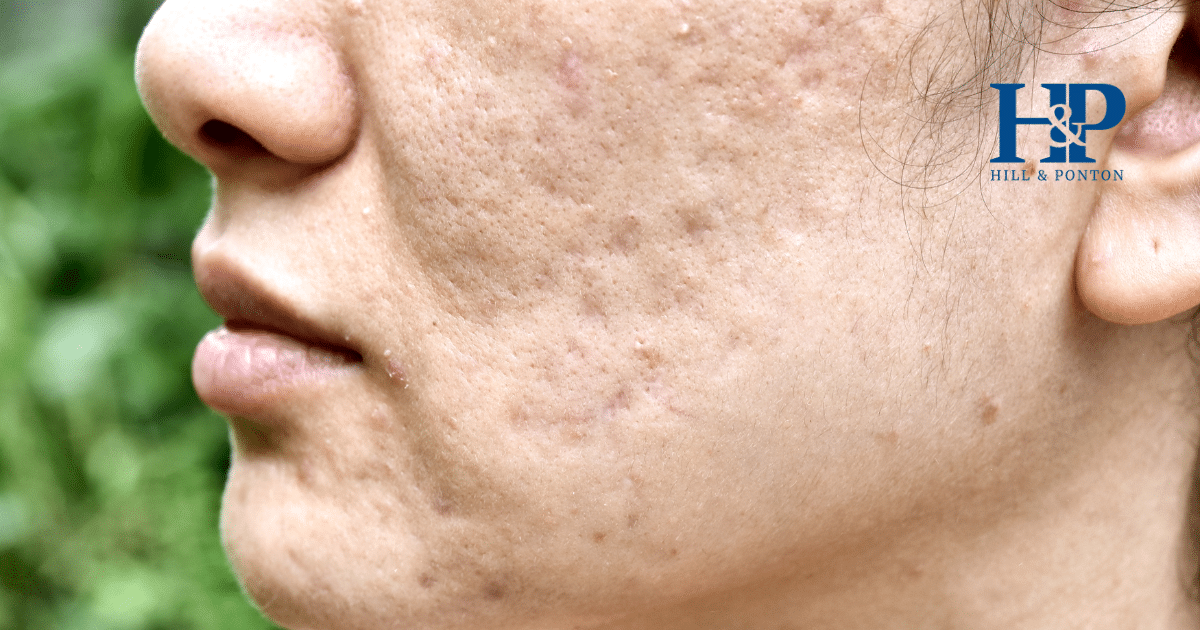Exposure to Agent Orange during military service has been linked to several serious health conditions, including chloracne, a painful and disfiguring skin disease that can significantly impact a veteran’s quality of life. Connecting chloracne to your military service allows accessing VA disability benefits and necessary medical care. Our guide will show you how to do that.
Chloracne VA Ratings and Compensation
Chloracne disability ratings are assigned by VA under 38 CFR § 4.118, Schedule of Ratings – Skin. The rating will be based on the severity and the specific areas of the body affected by the condition.
- 30%: Deep acne (deep inflamed nodules and pus-filled cysts) affecting 40 percent or more of the face and neck.
- 20%: Deep acne (deep inflamed nodules and pus-filled cysts) affecting the intertriginous areas (the axilla of the arm, the anogenital region, skin folds of the breasts, or between digits).
- 10%: Deep acne (deep inflamed nodules and pus-filled cysts) affecting less than 40 percent of the face and neck, or deep acne affecting non-intertriginous areas of the body (other than the face and neck).
- 0%: Superficial acne (comedones, papules, pustules) of any extent.
Scarring and Disfigurement
In cases where chloracne causes severe scarring or disfigurement, especially on the face or neck, a higher disability rating may apply. Severe tissue loss or asymmetry in key facial features could qualify for a rating as high as 80%, although this is rare in chloracne cases.
In some instances, if the scarring is severe enough, the VA may assign an additional disability percentage for scarring.
How Much Disability Can I Collect?
The amount of disability compensation is based on the percentage rating assigned by the VA. For 10% ratings and 20% ratings, the payment is fixed, while higher percentages depend on factors like marital status and family size. You can use our VA disability calculator to estimate your benefits.
How to Obtain VA Benefits for Chloracne
To prove that their condition is connected to their military service and qualifies for VA disability benefits, veterans need to provide:
- A current diagnosis of chloracne.
- Evidence of exposure to Agent Orange or another qualifying herbicide during military service.
- A medical nexus opinion linking the chloracne to the dioxin exposure during service.
Veterans may need to gather their military service records, medical records, and any supporting evidence (such as buddy statements) to prove their exposure and link to chloracne.
Chloracne from Agent Orange: Are You Eligible for a Presumption?
The easiest way to obtain benefits is through presumptive service connection for chloracne related to Agent Orange exposure. To qualify for it, veterans must meet specific criteria regarding time of service, location, and symptom onset:
- Chloracne must manifest within one year of exposure, and
- Veterans must meet the minimum disability rating of 10% as defined by the VA.
If these criteria are met, veterans do not need to provide additional evidence linking their condition to their military service.
Here’s a breakdown of the eligible locations where the VA presumes exposure to Agent Orange:
- Vietnam: Veterans who served on land, inland waterways, or on vessels operating no more than 12 nautical miles seaward from the demarcation line of the waters of Vietnam and Cambodia, as defined in the Blue Water Navy Vietnam Veterans Act of 2019 (Public Law 116-23), between January 9, 1962, and May 7, 1975.
- C-123 Airplanes and Agent Orange Residue: Veterans who were flight, ground maintenance, or aeromedical crew members may have been exposed to Agent Orange residue on C-123 planes flown during and after the Vietnam War.
- Korean Demilitarized Zone (DMZ): Veterans who served in units operating along the DMZ between September 1, 1967, and August 31, 1971, as determined by the VA and the Department of Defense (DOD), are presumed to have been exposed.
- Thailand Military Bases: Exposure is presumed for veterans who served on any U.S. or Royal Thai military base in Thailand from January 9, 1962, through June 30, 1976.
- Herbicide Tests and Storage Outside Vietnam: Veterans may have been exposed to herbicides during DOD tests or storage at military installations in the United States and other countries.
Additional Locations from the PACT Act: The PACT Act, signed into law on August 8, 2022, expanded presumptive service connections to the following locations:
- Any U.S. or Royal Thai military base in Thailand from January 9, 1962, through June 30, 1976.
- Laos from December 1, 1965, through September 30, 1969.
- Cambodia at Mimot or Krek, Kampong Cham Province from April 16, 1969, through April 30, 1969.
- Guam or American Samoa, or in the territorial waters off Guam or American Samoa from January 9, 1962, through July 30, 1980.
- Johnston Atoll or on a ship that called at Johnston Atoll from January 1, 1972, through September 30, 1977.
Even if you do not meet the specific criteria for these locations, or if your chloracne developed outside the one-year period, veterans may still establish a direct service connection by providing medical evidence linking their condition to dioxin exposure during their service.
Case Example: Winning a VA Disability Claim for Chloracne Due to Agent Orange Exposure
In this case, a veteran who served in the U.S. Army from August 1966 to August 1969, including one year of service in Vietnam, filed a claim for service connection and disability benefits for chloracne due to Agent Orange exposure. Initially, the veteran received a 10% disability rating for the condition but believed the symptoms were more severe than the VA had recognized. The veteran appealed the decision for a higher disability rating and an earlier effective date.
The Board of Veterans’ Appeals reviewed the appeal and decided to increase the veteran’s rating from 10% to 30%, acknowledging the veteran’s extensive symptoms of chloracne, including constant itching, extensive lesions, and significant disfigurement of the trunk and proximal extremities. However, the veteran’s request for an earlier effective date prior to February 4, 1991, was denied.
Key Factors That Contributed to Winning the Claim:
- Detailed Medical Evidence The veteran’s medical records showed extensive folliculitis, constant itching, and marked disfigurement, which aligned with the VA’s rating criteria for a higher disability percentage. VA medical examiners observed significant and ongoing symptoms, which strengthened the case for an increased rating.
- Service Connection to Agent Orange: The veteran’s service in Vietnam established presumptive exposure to Agent Orange, which linked the skin condition (chloracne) to their military service. This presumptive connection under Agent Orange exposure laws played a pivotal role in the case, as chloracne is a recognized presumptive condition.
- Alignment with VA Diagnostic Codes: The veteran’s symptoms matched the criteria for a higher rating under Diagnostic Code 7806 (which rates skin conditions such as eczema and dermatitis). The Board recognized the veteran’s extensive lesions, constant itching, and disfigurement, which merited an increase from 10% to 30%.
- Consistent Medical History: Despite the denial of an earlier effective date, the medical records demonstrated that the veteran’s skin condition had persisted and worsened over time, showing consistency in the severity of symptoms. This further substantiated the argument for a higher rating.
While the veteran’s request for an earlier effective date was denied, the successful increase in the disability rating demonstrates how persistent and thorough documentation can lead to a more favorable outcome. Veterans experiencing similar symptoms should gather strong medical evidence and consult with professionals to ensure their claims are accurately represented.
My Claim Was Denied, What Are My Options?
If your VA claim for chloracne has been denied, you still have options:
- Request a Higher-Level Review: Ask for a more experienced VA adjudicator to review your claim without submitting new evidence.
- File a Supplemental Claim: Submit new and relevant evidence to strengthen your case.
- Appeal to the Board of Veterans’ Appeals: You have one year from the date of the VA decision to file an appeal.
How to Increase the VA Rating for Chloracne
If your condition worsened or your initial VA rating for chloracne was too low, you may be eligible for a rating increase. To pursue a higher rating, veterans should:
- Submit new medical evidence showing that their condition has deteriorated.
- Request a new Compensation and Pension (C&P) exam to accurately assess the severity of their chloracne.
- Provide documentation of how the condition impacts daily life and employment.
Veterans who suffer from secondary conditions, such as depression or anxiety caused by disfigurement, may also qualify for additional VA ratings.




